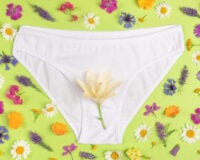Oh great, your period’s here. Time to pop some painkillers, break out the old heat pack, and resign yourself to between one and three days of unwanted cramping and pain. Sound familiar? You’re not alone. Between 70% and 90% of Australian women suffer period pain,1 with it so common that women often think it’s normal2 and don’t seek help for it.3 But pain is never normal, and you don’t have to put up with it! There are effective, natural ways to combat period pain, so you can feel more like yourself all month long.
What is Period Pain?
Also known as dysmenorrhea, it describes the painful abdominal cramping that starts at the very beginning of your period.4 It usually peaks after 24 hours of starting, and decreases again at the 48 hour mark,5 (typically). The pain may also affect your lower back or legs,6 or be accompanied by nausea, vomiting or diarrhoea.7 Unsurprisingly, period pain can negatively affect your wellbeing and enjoyment of life.8
Why Does It Hurt?
In order for the uterus to expel its lining each period, uterine contractions occur.9 Normally, these contractions are a painless process. However, in women with dysmenorrhea, the contractions have become more intense (and hence painful), 10 due to high levels of hormone-like signalling molecules called prostaglandins.11 Therefore, beating period pain involves lowering pain-triggering prostaglandins to a minimum.

Too Much and Not Enough
High prostaglandin levels can be caused by imbalances in oestrogen or progesterone, the major hormones which control the menstrual cycle. (Learn more about these hormones and the menstrual cycle here.)
Firstly, excess oestrogen exposure throughout the month can increase the production of prostaglandins, contributing to your pain. An oestrogen excess can develop due to inflammation, or exposure to endocrine-disrupting chemicals or ‘EDCs’. These chemicals behave similarly to your natural oestrogens, resulting in increased prostaglandin levels and worsening your period pain. Unfortunately, EDCs are now an unavoidable part of our environment, though there are ways to reduce your exposure – read how to here.
Your oestrogen levels are also influenced by your body’s ability to efficiently metabolise and clear excess oestrogen – one of the way this happens is via your liver, so supporting healthy liver function can help manage healthy hormone levels too, leading to a smoother menstrual cycle.
Low progesterone levels, caused by oestrogen excess and high levels of stress,12 may also contribute to period pain13 as insufficient progesterone is associated with high prostaglandin levels.14 Low progesterone is also associated with PMS, so if you ride the emotional rollercoaster in the lead-up to your period, your progesterone levels may need support!
What’s a Girl to Do?
1. Manage Your Symptoms
Did you know that there are effective, natural remedies that can help you manage dysmenorrhea? Like commonly used pain medications (e.g. paracetamol, aspirin and ibuprofen),15 these natural options are anti-inflammatory and pain-relieving.
- Turmeric is an Indian culinary herb which reduces prostaglandin levels.16 As an added benefit, turmeric has also been shown to reduce premenstrual syndrome (PMS).17 You can read more about the health benefits of turmeric here.
- Ginger is another anti-inflammatory culinary herb, shown to help reduce period pain. A recent scientific review found that taking 750 to 1000 mg of supplemental ginger during the first three to four days of a period significantly reduces pain.18
- Magnesium bisglycinate is a highly absorbable form of magnesium (e.g. Meta Mag®). Magnesium reduces prostaglandin levels19 and also reduces smooth muscle spasm, calming the intensity of those cramps. Low magnesium has been associated with both dysmenorrhea and PMS.20

2. Rebalance Your Hormones for the Longer Term
Herbs can offer effective support in balancing the activity of oestrogen and/or progesterone, depending on what’s causing your symptoms.
- Vitex agnus-castus increases progesterone production,21 reducing levels of pain-promoting prostaglandins. It does this by inhibiting high levels of a hormone called prolactin which disrupts the body’s production of progesterone.22 High prolactin levels can be caused by stress,23 and can contribute to PMS as well.24
- Soy isoflavones (constituents in soy foods) decrease excessive oestrogen activity by binding to and stimulating the body’s oestrogen receptors (binding sites on cells), reducing the negative effects of oestrogen excess. This triggers signals that reduce the inflammatory effects of oestrogen. To find out more about how soy does this, check out this blog. The constituents in soy also assist oestrogen clearance via the liver, helping support healthy oestrogen metabolism and lower prostaglandin levels.
- Milk thistle and rosemary support liver detoxification which, as aforementioned, contributes to healthy oestrogen levels; reducing prostaglandin levels, and pain.
3. Develop Healthy Hormonal Habits
Your health habits have the power to shape your periods. Incorporate the following diet and lifestyle strategies to reduce your pain and benefit your overall health at the same time.
- Exercise reduces stress, decreases pain sensitivity, and lowers prostaglandin levels.25 A recent review of the research found that moderate levels of physical activity throughout the month can reduce pain intensity.26 Aerobic exercise27 and yoga also increase quality of life for period pain sufferers.28
- A healthy diet high in fruit and vegetables and low in ‘trans fats’ (found in fried and processed foods) and animal proteins is anti-inflammatory and considered beneficial for overall health.
- Reducing EDC exposure can reduce oestrogen excess, as discussed above.

Get Help
If your period pain is getting you down each month, know that it isn’t ‘normal’, so don’t just put up with it! See a natural healthcare Practitioner to investigate the underlying cause of your pain, and to get a tailored plan that suits your situation. Beat your period pain and take back the month.
References
1. Subasinghe AK, Happo L, Jayasinghe YL, Garland SM, Wark JD. Prevalence and severity of dysmenorrhoea, and management options reported by young Australian women. Aust Fam Physician. 2016 Nov;45(11):829.
2. Iacovides S, Avidon I, Baker FC. What we know about primary dysmenorrhea today: a critical review. Hum Reprod Update. 2015 Sep 7;21(6):762-78.
3. Subasinghe AK, Happo L, Jayasinghe YL, Garland SM, Wark JD. Prevalence and severity of dysmenorrhoea, and management options reported by young Australian women. Aust Fam Physician. 2016 Nov;45(11):829.
4. Iacovides S, Avidon I, Baker FC. What we know about primary dysmenorrhea today: a critical review. Hum Reprod Update. 2015 Sep 7;21(6):762-78.
5. Mavrelos D, Saridogan E. Treatment options for primary and secondary dysmenorrhoea. Prescr. 2017 Nov;28(11):18-25.
6. Iacovides S, Avidon I, Baker FC. What we know about primary dysmenorrhea today: a critical review. Hum Reprod Update. 2015 Sep 7;21(6):762-78.
7. Mavrelos D, Saridogan E. Treatment options for primary and secondary dysmenorrhoea. Prescr. 2017 Nov;28(11):18-25.
8. Subasinghe AK, Happo L, Jayasinghe YL, Garland SM, Wark JD. Prevalence and severity of dysmenorrhoea, and management options reported by young Australian women. Aust Fam Physician. 2016 Nov;45(11):829.
9. Iacovides S, Avidon I, Baker FC. What we know about primary dysmenorrhea today: a critical review. Hum Reprod Update. 2015 Sep 7;21(6):762-78.
10. Iacovides S, Avidon I, Baker FC. What we know about primary dysmenorrhea today: a critical review. Hum Reprod Update. 2015 Sep 7;21(6):762-78.
11. Bernardi M, Lazzeri L, Perelli F, Reis FM, Petraglia F. Dysmenorrhea and related disorders. F1000Research. 2017;6.
12. Schüle C, Nothdurfter C, Rupprecht R. The role of allopregnanolone in depression and anxiety. Prog Neurobiol. 2014 Feb 1;113:79-87.
13. Bernardi M, Lazzeri L, Perelli F, Reis FM, Petraglia F. Dysmenorrhea and related disorders. F1000Research. 2017;6.
14. Bernardi M, Lazzeri L, Perelli F, Reis FM, Petraglia F. Dysmenorrhea and related disorders. F1000Research. 2017;6.
15. Subasinghe AK, Happo L, Jayasinghe YL, Garland SM, Wark JD. Prevalence and severity of dysmenorrhoea, and management options reported by young Australian women. Aust Fam Physician. 2016 Nov;45(11):829.
16. Khayat S, Fanaei H, Kheirkhah M, Moghadam ZB, Kasaeian A, Javadimehr M. Curcumin attenuates severity of premenstrual syndrome symptoms: A randomized, double-blind, placebo-controlled trial. Complement Ther Med. 2015 Jun 1;23(3):318-24.
17. Khayat S, Fanaei H, Kheirkhah M, Moghadam ZB, Kasaeian A, Javadimehr M. Curcumin attenuates severity of premenstrual syndrome symptoms: A randomized, double-blind, placebo-controlled trial. Comp Ther Med. 2015 Jun 1;23(3):318-24.
18. Daily JW, Zhang X, Kim DS, Park S. Efficacy of ginger for alleviating the symptoms of primary dysmenorrhea: a systematic review and meta-analysis of randomized clinical trials. Pain Med. 2015 Dec 1;16(12):2243-55.
19. Proctor M, Farquhar C. Diagnosis and management of dysmenorrhoea. BMJ. 2006 May 11;332(7550):1134-8.
20. Abraham GE, Lubran MM. Serum red cell magnesium levels in patients with premenstrual tension. Am J Clin Nutr. 1981;34(11):2364-6.
21. van Die MD, Burger HG, Teede HJ, Bone KM. Vitex agnus-castus extracts for female reproductive disorders: a systematic review of clinical trials. Planta Med. 2013 May;79(07):562-75.
22. van Die MD, Burger HG, Teede HJ, Bone KM. Vitex agnus-castus extracts for female reproductive disorders: a systematic review of clinical trials. Planta Med. 2013 May;79(07):562-75.
23. Sonino N, Navarrini C, Ruini C, Fallo F, Boscaro M, Fava GA. Life events in the pathogenesis of hyperprolactinemia. Eur J Endocrinol. 2004 Jul 1;151(1):61-5.
24. van Die MD, Burger HG, Teede HJ, Bone KM. Vitex agnus-castus extracts for female reproductive disorders: a systematic review of clinical trials. Planta Med. 2013 May;79(07):562-75.
25. Matthewman G, Lee A, Kaur JG, Daley AJ. Physical activity for primary dysmenorrhea: a systematic review and meta-analysis of randomized controlled trials. Am J Obstet Gynecol. 2018 Apr 7. doi: 10.1016/j.ajog.2018.04.001.
26. Matthewman G, Lee A, Kaur JG, Daley AJ. Physical activity for primary dysmenorrhea: a systematic review and meta-analysis of randomized controlled trials. Am J Obstet Gynecol. 2018 Apr 7. doi: 10.1016/j.ajog.2018.04.001.
27. Matthewman G, Lee A, Kaur JG, Daley AJ. Physical activity for primary dysmenorrhea: a systematic review and meta-analysis of randomized controlled trials. Am J Obstet Gynecol. 2018 Apr 7. doi: 10.1016/j.ajog.2018.04.001.
28. McGovern CE, Cheung C. Yoga and Quality of Life in Women with Primary Dysmenorrhea: A Systematic Review. J Midwifery Women’s Health. 2018 Jun 14. doi: 10.1111/jmwh.12729.









Leave a Comment